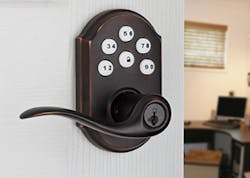Z-Wave Specifications Go Open-Source
The company responsible for drafting the Z-Wave home networking standard has made certain parts of the technology publicly available.
In an attempt to lure hardware and software developers to the standard, Sigma Designs last week released a public version of Z-Wave’s interoperability layer, which ensures that devices ranging from door locks to security cameras can share information.
The company has added the software to Z-Wave's open-source library. The code represents the “language” that defines how devices from different manufacturers talk to each other, said Raoul Wijgergangs, vice president of Sigma Design’s Z-Wave business. That makes it easier for home owners to connect devices with an internet gateway and control them remotely using a phone, computer, or tablet.
Z-Wave is also a wireless technology for creating mesh networks. In these networks, every device acts like a repeater that bounces wireless signals around a house or building. That method of skipping wireless signals between devices results in low power consumption, allowing devices to work for years without needing to replace batteries.
Sigma Designs also released a pair of APIs for making internet gateways, so that devices can send information – whether you left your garage door open, for example – with the cloud. The full specification behind Z-Wave’s security software is also available to the public, the company said.
With the code’s publication, software developers and hobbyists can teach devices the Z-Wave language with fewer restrictions. They are no longer forced to sign nondisclosure agreements with the Z-Wave Alliance, the industry group that maintains the standard, or buy a Z-Wave development kit.
Sigma Designs is the latest company to release public software in an effort to lure developers to its particular brand of home automation. Z-Wave contends with a wide range of other technologies for connecting devices to each other and the internet. But if the public version hits the mark, it could increase the number of devices using Z-Wave.
Z-Wave has a healthy start. Over 1,500 devices have been certified by the Z-Wave Alliance, which counts 350 companies, including Honeywell and Bosch, among its members.
But other wireless technologies are not sitting on the sidelines. Bluetooth and Wi-Fi are evolving to consume less power and create mesh networks, while other standards unique to home automation like Thread and Zigbee are also gaining acceptance.
There has been much talk in the consumer electronics industry about how closed standards are stunting the growth of smart appliances and other household devices. And attempts have been made to remedy that fragmentation: The Allseen Alliance and Open Connectivity Foundation have both released software for linking smart home devices. In May, the smart home division of Google parent Alphabet, Nest Labs, turned out a public version of the Thread mesh networking protocol.



